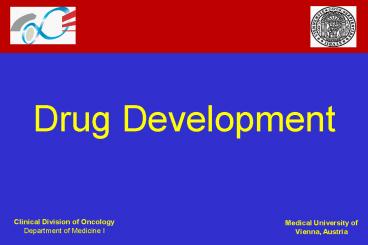Drug Development - PowerPoint PPT Presentation
1 / 14
Title:
Drug Development
Description:
Antitumor antibiotic (daunorubicin, doxorubicin) Streptomyces fungus ... Aberrant tumor suppressor genes (RB) Protein kinases. Transcription activators ... – PowerPoint PPT presentation
Number of Views:94
Avg rating:3.0/5.0
Title: Drug Development
1
- Drug Development
2
Drug development Steps in cancer drug
development
Identification of Candidate Compounds Screening
Preclinical Evaluation Production and
Formulation Phase I, II, III, IV Clinical
Trials General Medical Practice
3
Drug development Identification of candidate
compounds Natural products
Drug Type Source Antitumor antibiotic
(daunorubicin, doxorubicin) Streptomyces
fungus Vinca alkyloid (vincristine,
vinblastine) Vinca rosea plant Taxane Yew
tree Camptothecin (topotecan, CPT-11) Camptothec
a accuminata tree Podophyllin (etoposide,
teniposide) Podophyllum peltatum
plant Bryostatin, dolastatin, halichondrin Marin
e organisms
4
Drug development Identification of candidate
compounds Molecular-targeted screening
Computer-aided construction of molecules Mutant
oncogenes (BCR-ABL) Aberrant tumor suppressor
genes (RB) Protein kinases Transcription
activators
5
Drug development Screening for anticancer
activity
IN VITRO HUMAN TUMOR CELL LINE PANELS
Prostate
Ovarian
Melanoma
CNS
Breast
Colon
Lung
Nonspecific antitumor activity Highly
specific antitumor activity
In Vivo tumor panel human tumor xenograft
studies
Targeted preclinical development
Preclinical development followed by broad-based
clinical trials
Specific disease-oriented Phase I/II trials
6
Drug development Preclinical evaluation of
cytotoxic agents
IN VITRO
IN VIVO
Mechanism of action Stage I Stage II
- Target level Maximum tolerated dose Spectrum of
activity - Cellular level Dose-limiting toxicities Schedule
dependency - Efficacy Route of administration
- Cross resistance
- Combination therapies
7
Drug development Use of animal models for
evaluation of cytotoxic agents
Preclinical studies in mice, rats, and dogs
provide an important bridge from in vitro studies
to clinical studies Objectives Define major
toxicities Identify initial safe starting dose
for clinical trials
8
Drug development Clinical evaluation of
cytotoxic agents
Study Phase Objectives Patient
Population Phase I Identify maximum tolerated
dose Small (3-6 patients/dose level) Define
key toxicities Various tumor types Phase II
Evaluate tumor response Larger than Phase I
(10-50 Determine whether drug
patients/treatment group) warrants Phase III
study More uniform disease characteristics Phase
III Compare new treatment with Larger than
Phase II (100s of standard patients/treatment
group) Support marketing approval Same tumor
type Broader patient pool Phase IV Integrate
clinical study experience Very large cohorts
(100s-1000s) into general clinical practice
Represent general patient Monitor safety after
approval population
9
Drug development Clinical trials Efficacy
endpoints
Response rate Survival Disease-free survival Time
to disease progression Duration of
response Quality of life Pharmacoeconomics
10
Drug development Clinical endpoints Complete
remission
11
Drug development Clinical endpoints Partial
remission
12
Drug development Clinical endpoints Disease
Progression
13
Drug development Clinical trials Safety
analyses
Major toxicities Adverse effects Need for
dose/schedule modifications Discontinuation of
therapy during study
14
Drug development Summary of organization and
reporting of clinical studies

